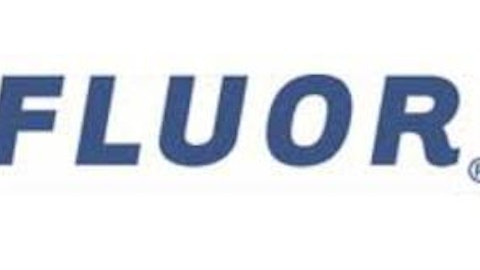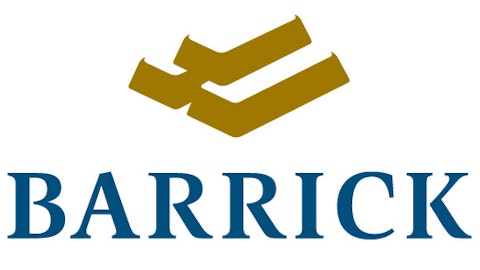When Barrick Gold Corporation (USA) (NYSE:ABX) announced earnings last week, while the numbers were good, it was the underlying message that should give investors hope. CEO Jamie Sokalsky took ownership of the challenges facing his company, and the industry in general, repeating his message of a quarter ago that the company is ratcheting down its controls to create a more streamlined operation that focuses on maximizing shareholder value.
“Investors are rightfully demanding fundamental change in the gold industry, and Barrick is driving this new paradigm,” Sokalsky said. While the stock rose initially on Thursday, Friday’s price action suggests that the market remains unconvinced; the $4.2 billion after-tax impairment charge was not likely to escape punishment. The company and the industry are getting the message that spending needs to be kept in check, and ultimately, Barrick is positioned to lead gold stock much higher.

Excluding the impairment, the company earned $1.11 per share, topping analyst estimates of $1.06. With the charge that resulted from a writedown in the company’s copper business, EPS came in at a loss of $3.06. Revenue rose to $4.19 billion for the quarter, representing an 11% increase. Year-ago quarterly earnings were $0.96 per share. The company expects to produce 7 million to 7.4 million ounces of gold in 2013, a decrease from the 7.42 million ounces produced in 2012.
While the numbers are solid, they aren’t the type of results that lead investors to get excited. Sokalsky noted in the earnings release the need for change: “Rising costs, poor capital allocation, and the pursuit of production growth at any cost in the industry have led to declining equity valuations across the sector. The message is clear: The industry must chart a new path forward.” These types of issues have led to some of the problems in the industry over the past few months and explain why Barrick has underperformed gold, as represented by the SPDR Gold Trust (ETF) (NYSEMKT:GLD), by 25% over the past year.
This is not a new message coming from Barrick, but the fact that its CEO is staying the course is encouraging: “Barrick highlighted the need for change last year, and we are increasingly taking strong action and refocusing our business based on the principle that returns will drive production, production will not drive returns.” It is this new spirit of discipline, replacing the mantra of growth at all costs, that has the potential to allow the gold industry to capitalize on both its inherent strength and the global macroeconomic factors that support a move higher.
A new era of accounting
One of the critical flaws in the gold industry has been how companies account for their costs. Under the current standard, certain factors necessary to sustain production are not included in the cost number, thereby making operating results skewed in favor of the company. The company has been actively working with the World Gold Council to define a new, more accurate definition of cost. The new definition of “all-in sustaining cash costs” is expected to be complete by the middle of 2013. Barrick has made clear its intention to abide by this standard as one of many efforts to give investors a clearer picture of the situation within the company.
To put this into some type of context, the company said it expects all-in cash cost to be between $1,000 and $1,100 per ounce in 2013 as compared with $945 in 2012. The inclusion of sustaining costs like mine evaluation, environmental rehabilitation, and general administrative costs adds to the total level of the figure. By more accurately reporting this number, however, not only will investors get a better picture of operation efficiency, but the company will be more able to focus on controlling all of these costs as well.
Changing the industry
As the largest gold producer in the world, Barrick is in a position to influence how the total industry behaves. The adoption of this standard will pressure competitors such as Kinross Gold Corporation (USA) (NYSE:KGC) and Goldcorp Inc. (USA) (NYSE:GG) to address similar issues. Within the past week, Kinross took a $3.09 billion writedown associated with impairments to its Tasiast Mine. Kinross CEO J. Paul Rollison said of the charge that the “impairment is a snapshot in time; it doesn’t necessarily reflect our view of the long-term potential of what this asset can be.” Still, the sting is very real. Goldcorp, which recently reported positive earnings, is beginning to adopt the new standard as well.
In addition to the company’s ongoing efforts to control costs, Barrick has made clear that it will immediately suspend the pursuit of any new projects. The company is looking to optimize its current portfolio to maximize shareholder value and take a more investor-focused approach. Sokalsky has maintained the message that growth at all costs is over for Barrick and the industry. This new discipline is bullish not only for the company; it is also bullish for the industry.
The article Can Barrick Lead Gold Stocks Higher? originally appeared on Fool.com and is written by Doug Ehrman.
Fool contributor Doug Ehrman and The Motley Fool have no position in any of the stocks mentioned.
Copyright © 1995 – 2013 The Motley Fool, LLC. All rights reserved. The Motley Fool has a disclosure policy.





